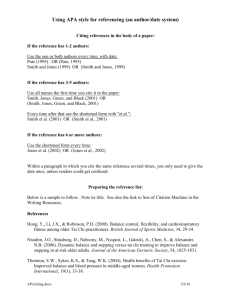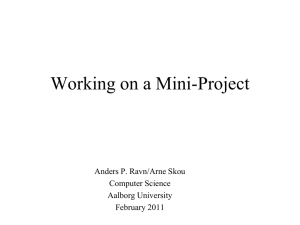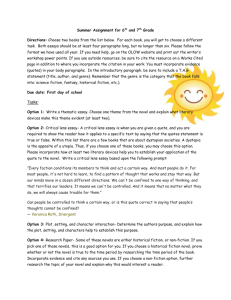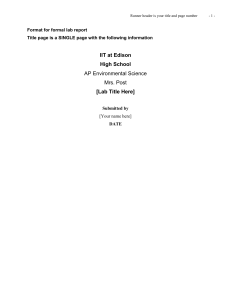RUNNING HEAD: A Short Title (it is typed here)
advertisement
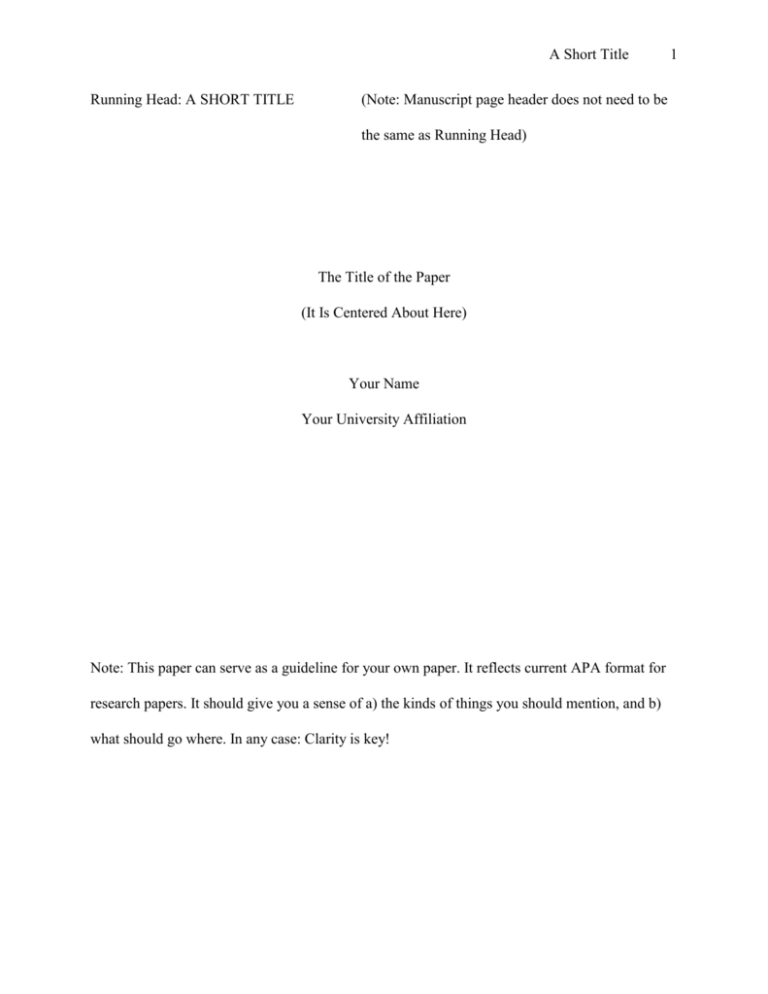
A Short Title Running Head: A SHORT TITLE (Note: Manuscript page header does not need to be the same as Running Head) The Title of the Paper (It Is Centered About Here) Your Name Your University Affiliation Note: This paper can serve as a guideline for your own paper. It reflects current APA format for research papers. It should give you a sense of a) the kinds of things you should mention, and b) what should go where. In any case: Clarity is key! 1 A Short Title 2 Abstract An abstract is a brief summary of the contents of the article. The abstract should tell the reader, in no more than 150 words, what problem was studied, what the experimental method entailed (briefly), what the conclusions were, and what the results implied. Writing a good, clear abstract is difficult because you want to get the most important research questions and research findings across using only minimal space. Good writing requires practice and editing. It helps to write the abstract last when you have a clear sense of what you are going to say in the paper. Note that the first line of the abstract is not indented. A Short Title 3 The Title of the Paper This next section is the introduction. Notice that it starts with the paper’s title and not the section heading Introduction. Start off with something to grab the reader’s attention, and in this first paragraph, introduce your topic broadly, without any jargon. An example, especially one you will return to, is a terrific way to start a paper. Do not leave the reader wondering about the topic of your research project. If the shape of your article is like an hour-glass, then the opening is like the wide-mouthed top. After providing a general context for the research project, the author should review the relevant literature. To supply the reader with enough knowledge to understand the importance and relevance of your research, you must provide some background on the topic. This is where you review the most relevant previous research. Typically, a research article does not contain a comprehensive review of the literature (APA, 1995). It is also a synthesis of what is know. Do previous researchers agree? Where do they disagree? When reviewing the literature, be sure to organize your review so that the discussion of the previous research flows logically. Try to begin each paragraph with a clear and relevant transition from the previous paragraph. Make the introduction more than a list of project descriptions. You should be sure to introduce all important concepts and to define any terms that you use. ). The literature review provides a rationale for your study. Your research should build on what is already known in the area. The third section of the Introduction is the “Transition.” The Transition is a sentence or section of the Introduction which ties the research you reviewed to your current study. This is the section in which you make the connection to your hypotheses. Explain to the reader how your A Short Title 4 study is building on past research—by extending it, filling in gaps left out in previous studies, or addressing limitations of past research. The final section of the Introduction discusses the hypotheses. This section is where you make specific predictions about your research. Tell the reader what relationships you expect to find among the concepts about which you are interested. These hypotheses should be based on past literature. The hypotheses should be testable. By “testable,” I mean that you can actually run an appropriate analysis on this question with the data we have—not on the data we might wish we had. Formatting Information In APA (American Psychological Association) style, all parts of the paper are doublespaced, and margins are one inch on all sides. Notice that the document is easy to read when you use sub-headings to divide up your paper. In general, use numerals (843 participants) when the number is 10 or larger. However, write out the number in words when the number starts a sentence. APA style has developed guidelines for the use of unbiased language. Be respectful of how people label themselves and use those identifiers in your writing. People participate in our studies; they are not simply are subjects. Do not use the pronoun “he” to refer to both sexes. Avoid the awkward he/she construction by making references to people in the plural (e.g., “researchers should be careful of their language” instead of “a researcher should be careful of his/her language.”) Citing Sources When describing the previous research, you must cite your sources properly. When describing a study, even when using only your own words, you must cite the author(s) of the A Short Title 5 reassert. Similarly, if you paraphrase someone else's ideas about a theory or concept, you must give the original thinker due credit. Failure to cite sources properly (and that often means at least one citation per paragraph in an introduction) is plagiarism. In APA style, references are cited by the last names of the author(s) and the date of the publication. For instance, if this sentence were a restatement of something said or suggested by Smith and Jones in 1993, one way to cite them would be to put the citation information in parentheses at the end of the sentence (Smith & Jones, 1993). Alternatively, you could be more direct: Smith and Jones, in their 1993 discussion of plagiarism, argued that failure to cite sources should be penalized by death. If the entire paragraph describes a particular study, the author(s) and date can be presented in parentheses at the end of the paragraph (Smith & Jones, 1993). Sometimes more than two authors collaborated on a given study. If three to five authors are involved, all of them should be listed the first time the reference is cited (Smith, Jones, Young, & Green, 1978). The next time this reference is used in the paper, only the first author is listed; the rest are referred to by et al., which means "and others" (Smith et al., 1978). If six or more authors are involved--say Jones, Smith, Sullivan, Sullivan, Green, and Young--you need list only the first author's surname, followed by et al. and the date of publication, even the very first time you refer to this sources (Jones et al., 1990). In the reference list, however, all of the names must be listed. Quoting Sources I highly recommend you not use direct quotes at all, unless someone has said something so well that you could not possibly say it better. Occasionally, however, you might want to quote someone directly. If the quote consists of fewer than 40 words, "put the quote within quotation marks, and follow the quotes with the source and page number" (Meyer, 1987, p. 123). Similarly, A Short Title 6 the author might be mentioned earlier in the sentence: As Meyer (1987) noted in her earlier work on quotations, "Quotations should be used sparingly, and only when they add to the content of the paper" (p. 123). Notice that when the author is mentioned in the main text of a sentence, the date of the publication appears in parentheses immediately after the author's name. The page number must always be included when you quote directly. Quotes containing more than 40 words require a block quotation: For a block quotation, the left margin is set in five spaces, and the first word of each paragraph within the quote is set in an additional five spaces. The right margin remains at the same place and that the quote is double-spaced, just as the rest of the paper is. When the quote is complete, citation information that did not appear immediately prior to the quotation is provided in parentheses at the end. This includes the author(s), the publication date, and the page number (Sullivan & Sullivan, 1991, p. 78). The current study If this sample paper had a substantive topic, this heading would be a good way to let the reader know it is time to focus on the conceptual design of the current research. You could put information about how you are extending the previous research here. Briefly describe your project in general terms (you will be supplying the nitty-gritty details in the methods section). You should also introduce your hypotheses and make the rationale for your expectations clear. Hypotheses should follow logically from the literature you discussed previously. The last thing you say in the Introduction should be your hypotheses themselves, not the rationale for them. Method Participants A Short Title 7 Everything in this section should be in the past tense. The first subsection of the methods section is typically the participants' section. How many people participated? How were they assigned to the experimental conditions, and how many were in each condition? Were the participants volunteers from a course, or from some other population? You should also describe your participants in terms of their characteristics, such as their age and their gender. Be specific. Provide actual numbers and percentages. Rather than saying most of the participants were women, tell me that 73% of participants were female. If your study was longitudinal, did you lose participants? (If you think participant attrition is a problem for analysis interpretation, that discussion should logically enough go in the Discussion section.) Materials In the next subsection, the materials used in the study are described. Any psychological tests or questionnaires used in the project should be described in this section. Included with the descriptions should be information about the actual range of scores as well as the possible range of scores. Procedure In the procedure subsection, explain, clearly and completely, all the steps taken in conducting the research. Describe how people were assigned to groups or how you determined whether subjects met the criterion for admittance to the study. Any measures used to control or balance the effects of extraneous variables should be described here. Instructions to the participants should be paraphrased or summarized. However, if the instructions included the experimental manipulation -- that is, if the different instructions are themselves being compared - the instructions should be presented verbatim. Results A Short Title 8 In this section, the type of data collected and the statistical techniques used to analyze them are described. The results of the analyses are also presented, and general conclusions are made. For example, an author might first remind us of the conceptual hypothesis: Recall that we predicted that happy people would remember more than sad people. Then tell the author would tell us what the operational prediction would be: In particular, we expected that happy people would correctly remember more items from the memory test than the sad people. Third, the author lets us know what happened: They did. Only at this point, once the author has reviewed the hypothesis and result in English, should the author start to talk statistics. As shown in Table 1, the subjects in the mnemonic condition recalled significantly more words (M = 15.73) than those in the control condition (M = 9.36), t (12) = 7.62, p < .05. The previous sentence informs the reader which group scored higher, provides the actual numbers, and gives us the statistical test. The author should not expound on why the results occurred. Implications of the results are presented in the discussion section. For demonstration purposes, I also prepared a graph (please see Fig. 1). Note that the caption or description of the graph goes on a separate page (Figure Captions). My conceptual hypothesis was that social support leads to greater life satisfaction. I predicted that married people would be more satisfied with their lives than single or divorced people. This hypothesis was not supported. Single (M = 2.22) and divorced (M = 2.67) respondents were just as satisfied with their lives as married ones (M = 2.58) , F (3, 95) = 1.79, n.s. Post-hoc comparisons revealed no differences among groups. Examination of the standard deviations indicates that there is considerably more variability in the life satisfaction of single people than married or divorced ones (please see Fig. 1). A Short Title 9 When presenting the results of statistical analyses, assume that the reader has a basic understanding of statistics. You do not need to explain the concept of rejecting the null hypothesis, what a t-test is used for, or what a significant p-value is. You should, however, supply the reader with information about the value of the test statistics, the degrees of freedom, the probability level, and the direction of the effect, as was done in the preceding example. Usually it is more efficient and easier to understand data that is represented in a table or a figure. Any tables or figures should be mentioned in the text, and the reader should be told what to look for, as in the preceding example. When typing a table, you should prepare the table on a separate piece of paper, and put it at the back of the manuscript (See Table 1). A table is presented at the end of this sample paper so that you can see how tables are prepared. Notice that the table is double-spaced throughout. Discussion Typically the discussion begins with a statement about the data’s support or nonsupport of the hypotheses. Restate your findings in terms of your hypothesis. Do your findings support the theory? For example: No difference was found in depression after a flood between married and single people. This finding did not support our hypothesis. Furthermore, these results are contrary to previous research, which found that those with social support were less depressed following traumatic events. Take a moment to think about the “shape” of the paper. The Method & Results sections were the narrowest part of the hourglass. Now, the Discussion section will move from the narrow neck to the broad base. The purpose of the Discussion is to answer any questions raised earlier in the paper and to conclude your paper thoughtfully. How do you do this? First by discussing A Short Title 10 everything you presented in the Results section and then placing it in the context of the theory from the Introduction. Next, try to discuss the implications of your findings. Try to integrate the results with the literature you discussed in the introduction. What are the implications for the theory you based your predictions on? You can discuss why some results may not have come out as expected, or what the implications of the present results are in relation to previous work and to the underlying theory of the paper. You may also want to discuss limitations of the study, however, this should not be the main focus of your discussion. Too much focus on this aspect makes you look like you did not know what you were doing. Instead, focus your discussion of limitations to issues that could be addressed in the future or that make sense theoretically. In general, you are answering the question “Do I still believe my theory?” Your discussion should end broadly. What has this project contributed? What questions has it answered? How could your findings influence people lives or the way we think about the world? What paths might future researchers follow? Answering these questions can take your discussion far. A Short Title 11 References American Psychological Association (1995). Publication Manual of the American Psychological Association. Washington, DC: Publisher. Jones, R.L., Smith, J.K., Sullivan, J.D., Sullivan, W.S., Green, G.G., & Young, T.W. (1990). Something remarkable prolix, sententious, and orotund. In Digest, 15, 212-298. Meyer, R.C. (1987). The title of an article is typed like this. The Journal is Underlined, 23, 34-37. [Note: the 23 is the volume number, it is underlined. The numbers 34-37 are the page numbers, they are not underlined.] Smith, J.K., & Jones, R.L. (1993). The title. The Journal, 12, 44-78. Smith, J.K., Jones, R.L., Young, T.W., & Green, G.G. (1978). The article title. Another Journal, 17, 48-56. Sullivan, J.D., & Sullivan, W.S. (1991). The title of a book. New York: The Publisher. NOTE: All titles should be underlined, NOT italicized. Italicizing occurs in published articles. A Short Title Table 1 Mean Correct Recalled Items as a Function of Mood Mood N Mean Std. Dev. Happy 25 15.73 .39 Sad 32 9.36 2.87 12 A Short Title Figure Caption Figure 1. Mean life satisfaction life satisfaction as a function of marital status. (You’d put a page break here but I won’t because this document is already so long.) 3.2 3.0 2.8 2.6 2.4 2.2 2.0 1.8 1.6 1.4 N = 3 40 8 single married divorced Current marital status 13
